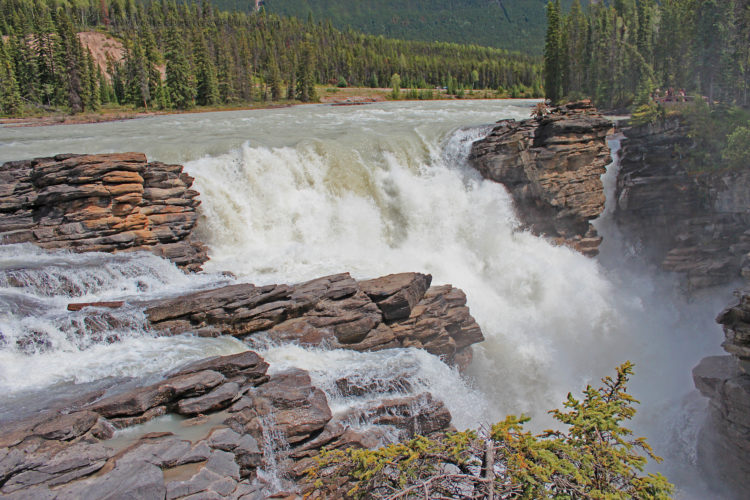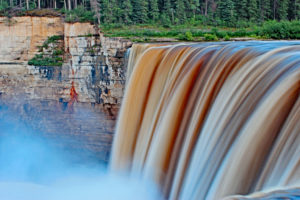
When it comes to waterfalls, we often get caught up with measurements of height. Sure, the taller the waterfall, the more majestic it appears to be. But, nothing is more a measure of Mother Nature’s raw power than volume.
There’s something about that power that truly makes any human being feel small and vulnerable. In the case of a few of the eleven waterfalls we’ll look at today, you even have a chance to be alone, up close and personal with these marvels.
Let’s start from number 11 and work our way up to number 1…
Top 11 Canadian Waterfalls (Average Flow Rate)
11. Athabasca Falls
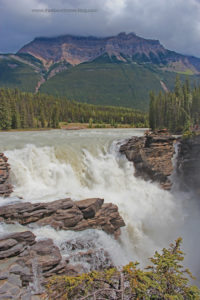
The reason why we extended the list to 11 instead of just a standard top 10 is simply because #11 was Athabasca Falls. The fact that this waterfall has an average width of just 98 feet, you’re getting a lot more visual impact from the 113 cubic metres per second (4,000 cubic feet/second) that make the 79 foot drop.
This waterfall is, of course, quite famous as one of the main attractions within Jasper National Park in Alberta. Just off the main highway and 30 kilometres south of the Jasper townsite, you will never be alone when viewing this wonder. In fact, it can be a struggle just to find a parking spot.
The waters of the Athabasca River are sourced from the nearby Columbia Icefield. Eventually, the river makes its way to the Peace River, home of number two on the list today.
10. Marcus Falls
Located on the Clearwater River in eastern British Columbia, Marcus Falls has an average flow rate of 122 cubic metres per second or 4,300 cubic feet per second, just slightly more than Athabasca. But, at 350 feet, it is more than three times as wide. This waterfall is rather short, as well, at just 15 feet in height.
9. Baileys Chute
A short distance upstream on the Clearwater River from Marcus Falls in Baileys Chute. This waterfall has the exact same flow rate as its neighbour. However, its width is less than half at 151 feet. Baileys is twice the height of Marcus at 30 feet. However, that 30 feet runs for 200 feet in what is labeled as a gradual sliding cascade.
Baileys Chute is located within Wells Gray Provincial Park on the eastern side of British Columbia, near the Alberta border. The waterfall is named for Jim Bailey. Bailey was an engineer who drowned just below the falls in 1952 after his canoe capsized.
8. Montmorency Falls
If a river’s got to end, it should end in style. If the Montmorency River was a living entity, I’m sure that’s what it would be thinking. Montmorency Falls in Quebec City, Quebec is a 276 foot drop at the point where the river empties into the St. Lawrence.
The average volume of water flowing over Montmorency Falls in 130 cubic metres per second (4,600 cubic feet). What makes this waterfall such a tourist draw, other than its location within a major city, is the height of 276 feet, almost 100 feet higher than Niagara.
7. Rearguard Falls
Some 1,260 kilometres from the Pacific Ocean by way of the Fraser River is Rearguard Falls in British Columbia. The volume here is 171 cubic metres/second (6,000 cubic feet). The height is just 20 feet while the width is 200 feet.
6. Louise Falls
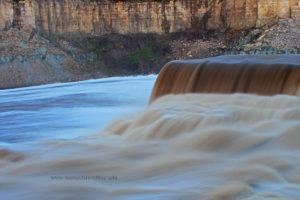
This is actually a tie for fifth with Alexandra Falls, found three kilometres upstream on the Hay River in the Northwest Territories. An average of 282 cubic metres (10,000 cubic feet) rush over this unique waterfall every second. Louise Falls has a unique look that is best explained by watching the video.
This waterfall is 49 feet in height and 600 feet wide. The best part is you can camp at the adjacent Twin Falls Gorge Territorial Park. From your site, it’s a quick hike to this waterfall and Alexandra Falls.
5. Alexandra Falls

Sharing identical volume with Louise, Alexandra Falls offers a different view. It’s a clean drop of 105 feet than sort of resembles the Horseshoe Falls portion of Niagara. Dubbed Hatto Deh Naili in the Slavi language, Alexandra is located just over 40 kilometres from the town of Hay River.
4. Chutes De La Chaudiere
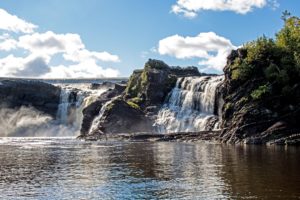
It’s harnessed by a hydro-electric dam but Chutes De La Chaudiere is still quite a sight. Located in Levis, Quebec, this waterfall can be seen as you pass Quebec City on Highway 20. At this point, the Chaudiere River dumps an average of 500 cubic metres (18,000 cubic feet) per second over the jagged rock.
The height of the waterfall is 115 feet while the width is 790 feet. The area is easily explored by an extensive trail system. Those trails include a pedestrian suspension bridge just downstream that offers great views of the waterfall and of Quebec City if you look in the opposite direction.
3. Virginia Falls
On a visit to Fort Simpson in the Northwest Territories in 2016, we missed a plane ride to see Virginia Falls by a day. An ad posted at the town hall stated a local tour company had open seats due to a cancellation but, we missed out. Fort Simpson (or just Simpson, as the locals tend to drop the Fort from town names) still an impressive place at the confluence of the Liard and MacKenzie Rivers and is a must see if you’re ever in the area.
Anyway, Virginia Falls has a volume of 1,000 cubic metres per second (35,000 cubic feet). It is twice the height of Niagara at 315 feet with a width of 850 feet. Located on the South Nahanni River, this waterfall is found within the Nahanni National Park Reserve.
2. Vermilion Falls
On that same 2016 trip, I wish I’d known of the existence of Vermilion Falls. It turns out, we passed within a short drive of this waterfall in Northern Alberta without even knowing it. It is located on the Peace River, just downstream from Fort Vermilion.
Not only is this Canada’s second largest waterfall by volume with a flow rate of 1,812 cubic metres per second (64,000 cubic feet) but it’s also a world leader in a different category.
Vermilion Falls is a whopping 1.8 kilometres or 6,000 feet wide! This makes it the sixth widest waterfall in the world. However, the height is just 15 feet. In fact, in high water seasons, small flat bottomed boats are actually able to navigate up and down the waterfall.
1.. Niagara Falls (of course…)
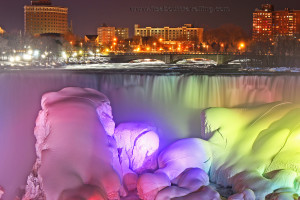
This is one of the world’s top tourist draws for a reason. Niagara Falls (the collective name for Horseshoe, American and Bridal Veil Falls put together) has an average volume of 2,407 cubic metres per second (85,000 cubic feet) dropping over a height of 167 feet.
However, this doesn’t come without controversy. After all, is it a Canadian waterfall? About two third of Horseshoe Falls is in Canada. The rest, along with all of Bridal Veil and American lie within New York state in the U.S.
Regardless, the Niagara River as it takes its short journey from Lake Erie to Lake Ontario is incredibly powerful, awe-inspiring and downright beautiful, no matter which side of the border you’re viewing from.
Have You Seen Them All?
Vermilion Falls is not the only one of these eleven that we personally have missed out on, to date. But, we have had the fortune to visit five. Living less than a two hour drive from Niagara means we visit quite often. But, even after all these years, I seem to see the cascade a little differently each time.
On our 2016 Northwest Territories road trip, we took in Alexandra and Louise Falls, along with a few others on NWT’s ‘Waterfall Route’. To be alone at the edge of these massive waterfalls is an incredible feeling. To be alone at the edge in the eternal dusk after midnight on an early July night is an even more incredible feeling.
On that same 2016 trip, and several times as a youth for me, we visited Athabasca Falls. The crowds couldn’t take away any of the magic as an impossible amount of water rushed down this gauntlet.
The fifth is Chutes de la Chaudiere. We’d often spotted it from the highway while passing through Quebec City on our way to the Maritime provinces but finally stopped in 2018 when we trooped down in the motorhome. We stayed the night at the Quebec City KOA kampgound on the opposite side of the highway. It was just a short drive in the morning to the parking lot.
Chaudiere sits in the tourism shadow of Montmorency but it is something that should not be missed. The trails are excellent and you can get pretty up close and personal on the rocks below the falls.
As for the other six, they’re part of a very long and ongoing list of places we want to see on this earth during our lifetimes.
How many have you seen in person? We’d love if you’d share your experience in the comments below…
